The Evolution of C8, The Optical Tube
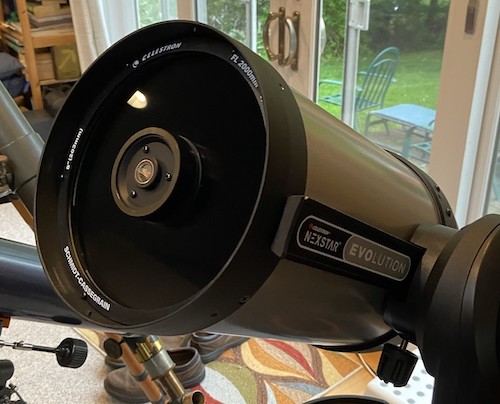
As the name of the telescope suggests, the NexStar Evolution 8 is an evolution from the older line of Celestron telescopes. The Evolution 8 is the latest of Celestron’s 8” Schmidt-Cassegrains, known as the C8, with design roots dating back to the 1960s and the original orange-tube C8 having debuted in 1970.
Apart from updates to the coatings and manufacturing process, the C8 has changed little in terms of performance or design in the past 50 years.
Celestron does sell a C8 EdgeHD in various incarnations that have improved field flattening for astrophotography and ventilation holes. In fact, the Celestron Evolution 8 itself is available with an EdgeHD upgrade and a StarSense autoalign bundle, but I don’t see a reason to shell out the funds. The EdgeHD won’t perform any differently for visual observation use, and the StarSense, as I value it, is unnecessary.
C8’s Long Focal Length and Its Implications
The C8 is an SCT, or Schmidt-Cassegrain Telescope. The SCT telescopes use a corrector plate in the front, an extremely fast primary mirror, and a convex secondary mirror.
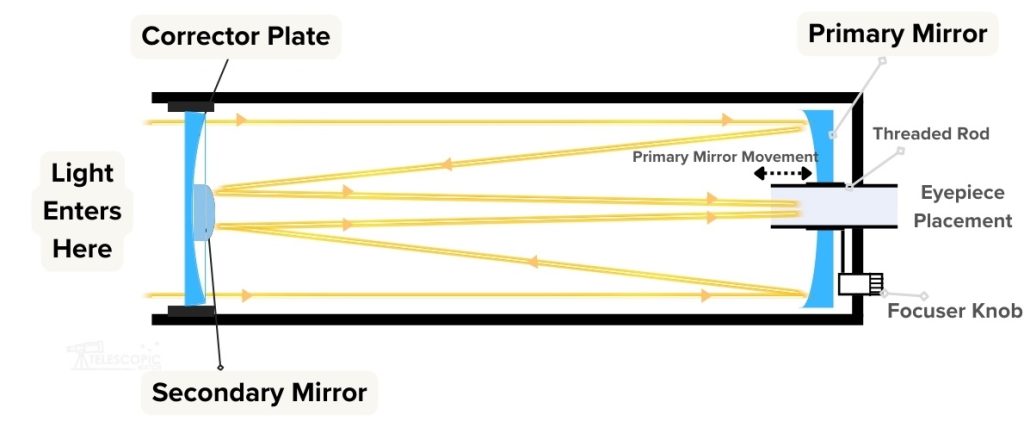
The advantage of the SCT design is that it makes the tube length extremely short thanks to the fast f/2 primary mirror, as in the case of the C8. But the true focal ratio of the telescope is f/10 after reflecting off of the secondary mirror.
The Evolution 8, as the name suggests, is a telescope with an 8” (200mm) aperture. This is an ideal aperture size for beginning astronomers or those who want something portable yet with decent views. But I’d still warn you that 8 inches is not likely to reveal great detail on dimmer objects, especially galaxies, so this telescope is more suited to nebulae, star clusters, planets, etc., which are all relatively bright objects.
Buy Evolution 8 from HighPointThe focal ratio of f/10 leads to a focal length of 2000 mm (Focal Length = Focal Ratio (10) x Aperture Diameter (200 mm), which is a very long focal length for such a compact telescope. The high magnifications due to the such long focal lengths are a great feature when I use it for planetary observing. On the other hand, the resulting narrow field of view does make it tricky at times for me to do wide-field observation. But for most targets, I find this to not be a problem.
My Take on Evolution 8’s HyperStar Compatibility
The C8 has built-in HyperStar compatibility. This means that if you purchase Starizona’s Hyperstar corrector, you can remove the secondary mirror and put the Hyperstar in its place to do astrophotography at f/2 focal ratio with the help of a cooled astrophotography camera.
Not all cameras will work with this HyperStar configuration. Monochrome cameras with filter wheels won’t reach focus, and if I were you, I’d also be careful not to obstruct the aperture with a large camera housing.
Additionally, a HyperStar costs more than the entire telescope and isn’t that useful unless I put the C8 on an astrophotography-friendly equatorial mount in place of the altitude-azimuth mount that the NexStar Evolution 8 comes with.
The Included Medium-Quality Eyepieces
The Celestron NexStar Evolution 8 includes two Plossl eyepieces: a 40mm and a 12.5mm. I found these to be decent, but being the included eyepieces, they are still not of great quality, I’d say.
Being Plossls, they have a small apparent field of view, which means I only see a small circle when looking through the eyepiece. Eyepieces with a larger field of view are typically more immersive, as the area filled with light is larger and takes up more of my sight.
The included eyepieces may be able to get you started observing, but you will most likely want to upgrade fairly soon after you purchase the scope.
A Mount Well Made
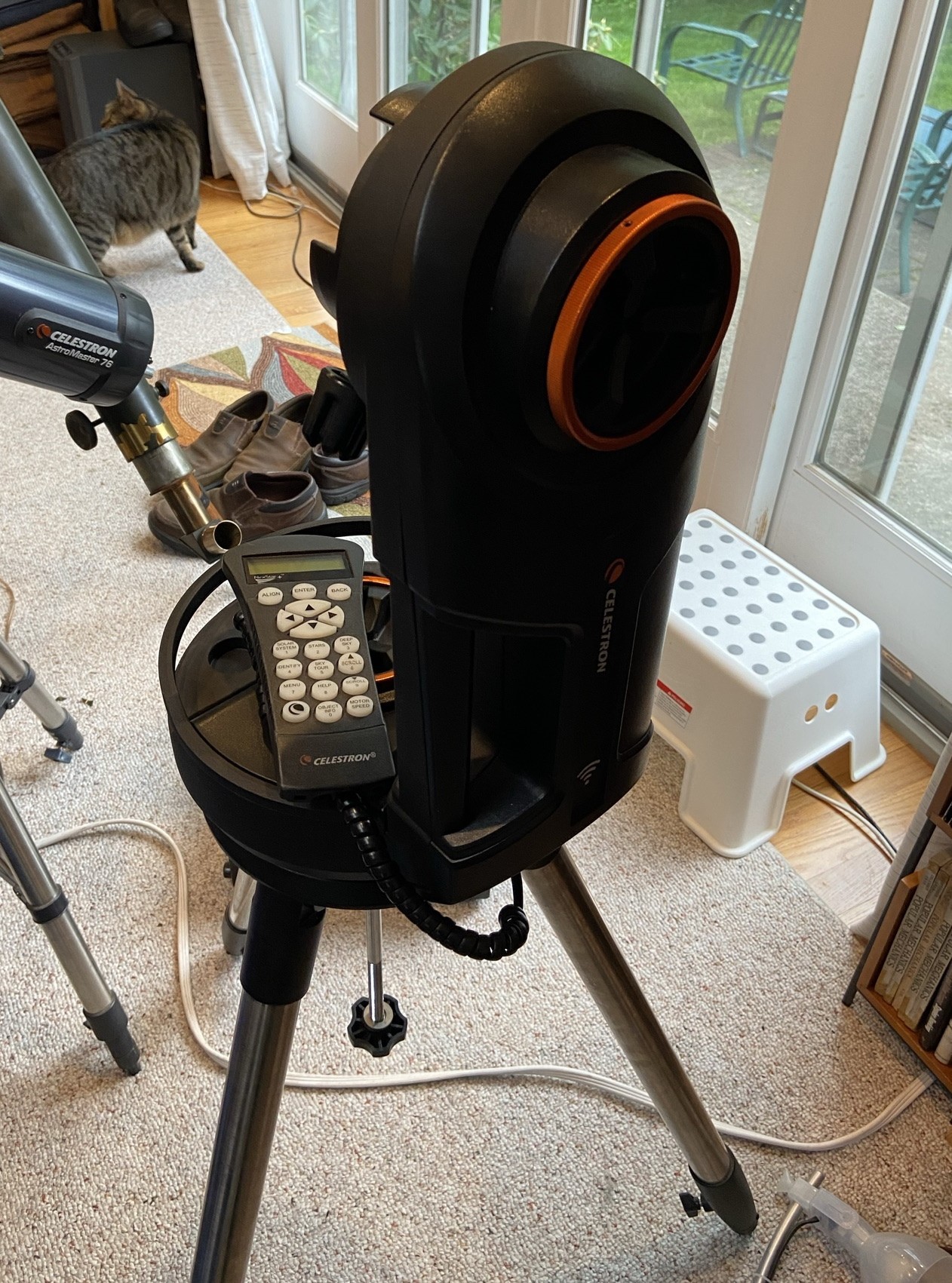
The NexStar Evolution 8, as with all the NexStar telescopes, is meant for use by visual astronomers. As the mount is an altitude-azimuth (Alt/Az) rather than an equatorial (EQ) mount, you will most likely have a difficult time trying to take images with it as the night progresses due to the effects of field rotation.
For visual use, I favor Alt-Az over EQ telescopes because of their ease of use and simple directional pointing. Also, unlike an EQ mount that requires careful polar alignment, an Alt-Az mount only requires a 2 or 3-star alignment to be able to use the telescope, slew, and track. The pointing accuracy of the Evolution mount after the 3-star alignment happens to be excellent as well.
The Evolution mount features built-in Wi-Fi.
This is one of the only all-in-one telescope systems to be able to be slewed from WiFi WITHOUT an adapter! What this means is that I always have an incredibly easy time being able to connect to the mount without any troubles or messing around with adapters or complicated software.
You can control the mount from any mobile device that has WiFi using Celestron’s app, SkyPortal. SkyPortal is based on the awesome SkySafari app, which I highly recommend, and as such, it includes 100,000 targets plus the ability to slew to any point in the sky, while also being tied in with the excellent planetarium software.
The mount includes a lithium battery inside, which means I don’t need to buy a typically very expensive external battery, and it lasts far longer than many of the lead-acid batteries sold for powering telescopes. The battery can also charge USB devices, which is useful when my smartphone won’t last the whole night.
The NexStar+ hand controller includes over 40,000 objects in its database and an internal time clock, which means that I do not have to enter the time and date every time I start up the mount if I choose to enable it.
The controller includes 9 slew rates for intricate and accurate slewing and pointing. That means I can go from rate 9, which moves the mount several degrees per second, to 1, moving at half the speed of the stars.
Should I buy a used NexStar Evolution 8?
A used Evolution would be a great telescope if the price is reasonable.
Be sure to check that the built-in battery, WiFi, and, of course, the electronics work. Since these telescopes haven’t been around for very long, there’s little concern about any major electronic failures, but as time goes on, you should be more wary of components, particularly the battery, ceasing to work on older models.
Alternative Recommendations
The NexStar Evolution 8” is a nice telescope. It is far from the cheapest scope I’d recommend. At and below its price range, there are a lot of other options that offer you different capabilities:
$500-$1000
- Manual Dobsonian Scope: The Apertura AD10 offers a bit more light-gathering and resolving power than the NexStar Evolution 8 while still remaining affordable and including a wide variety of high-quality accessories to get you started. The smaller AD8 is nearly as capable, though the two sizes differ little in weight and bulk, and the 10” model gets you a lot more performance for not much more money.
- Computerized Tabletop Dobsonian Scope: The Sky-Watcher Virtuoso GTi 150P isn’t as powerful as the NexStar Evolution 8 but costs a fraction as much while still featuring fully motorized GoTo and tracking controlled over WiFi, a compact form factor thanks to its collapsible tube, and a mighty 6” of aperture capable of showing you plenty of Solar System and deep sky object delights.
$1000-$2000
- Manual Dobsonian Scope: The Apertura AD12 includes a variety of high-quality accessories, as with the smaller 8” and 10” models, and provides far brighter and crisper views than the NexStar Evolution 8 thanks to its huge 12” primary mirror.
- Partially Computerized Dobsonian Scope: The Celestron StarSense Explorer 10” Dobsonian’s larger aperture than the NexStar Evolution 8 gives it greater light-gathering and resolving power, while the StarSense Explorer technology makes it easy to get aimed at deep-sky objects in seconds without external power or motors, and the Dobsonian base is remarkably lightweight, making it easy to transport and set up.
- Computerized Dobsonian Scope: The Sky-Watcher 10” FlexTube GoTo Dobsonian offers a bit more aperture and a lower price tag than the NexStar Evolution 8, with the same GoTo and built-in WiFi features. It comes with the added bonus of allowing you to aim the scope manually even while the GoTo system is powered on, thanks to the FreedomFind encoder system.
- Computerized Tripod-Mounted Scope: The Celestron NexStar 6SE is less capable than the NexStar Evolution 8 but much cheaper and more compact, ideal if you want a scope for air travel and prefer the Schmidt-Cassegrain design. We would recommend avoiding the larger 8SE, as it is too big for its mount/tripod and thus unsteady.
$2000-$3000.
- Computerized Dobsonian Scope: The Sky-Watcher 12” FlexTube GoTo Dobsonian offers fully motorized tracking and aiming abilities with the option to freely point the scope manually thanks to its built-in FreedomFind encoders, and with the GoTo system controlled entirely over WiFi. It is fairly easy to collapse and transport, though not as compact as a true truss tube Dobsonian.
- Computerized Tripod-Mounted Scope: The Celestron Advanced VX 9.25” SCT has a bit more light-gathering area as well as resolving power compared to the Evolution 8” and isn’t much heavier or bulkier, though assembling and setting up the Advanced VX mount is quite a bit more complicated.
- Computerized Tripod-Mounted Scope: The Celestron NexStar Evolution 8″ EdgeHD with StarSense adds the EdgeHD optics upgrade and StarSense AutoAlign technology to the 8” Evolution, which are nice bonuses if you’re looking for the ultimate top-of-the-line telescope package.
Aftermarket Accessory Recommendations
While the eyepieces Celestron provides with the NexStar Evolution 8 are adequate, a 2” dielectric mirror star diagonal coupled with a wide-angle 2” eyepiece such as the Apertura 38mm SWA (53x) will enable the widest possible true field of view with the scope. A higher magnification than the stock 12.5mm Plossl unit’s 163x may also be ideal; either an Explore Scientific 8.5mm 82-degree (239x), Agena 8mm Starguider (254x), or 9mm redline/goldline would be ideal. Even higher magnification with an eyepiece in the 6mm range, such as a 6mm “goldline” (339x) or Explore Scientific 6.5mm 82-degree (313x), would also be useful on the steadiest of nights.
You’ll also want a dew shield to keep condensation off your Evolution 8’s front corrector plate, which also reduces the likelihood of leaving a fingerprint on the optics and acts like a lens hood, increasing contrast at the eyepiece in the presence of severe glare from the moon or light pollution.
A UHC nebula filter is also a must-have, increasing contrast on nebulae under light-polluted conditions and improving your view even under dark skies by further darkening the background. A 2” unit will work with both 2” and 1.25” eyepieces if you have purchased a 2” diagonal for the scope.
What can you see with the Celestron NexStar Evolution 8?
The Evolution 8’s moderate aperture and long focal length mean it’s not likely to be the best at deep-sky objects, but it still packs a fair amount of punch.
Viewing spiral arms in many of the bright galaxies and beginning to delve into the Herschel 400 list of objects is no problem under dark skies. Even from a city, the Orion Nebula looks magnificent, and I’m able to resolve the brighter globular clusters like M13 and M22 into swarms of stars.
The Moon and planets look great—I’ve had no trouble picking out the cloud belts on Jupiter and Saturn, along with their various moons, and, of course, the eclipses and transits of Jupiter’s—along with, of course, the phases of Venus and Mercury, and a few dark spots on Mars. Uranus and Neptune are bluish dots, and Neptune’s lone large moon, Triton, is faintly visible under good conditions.

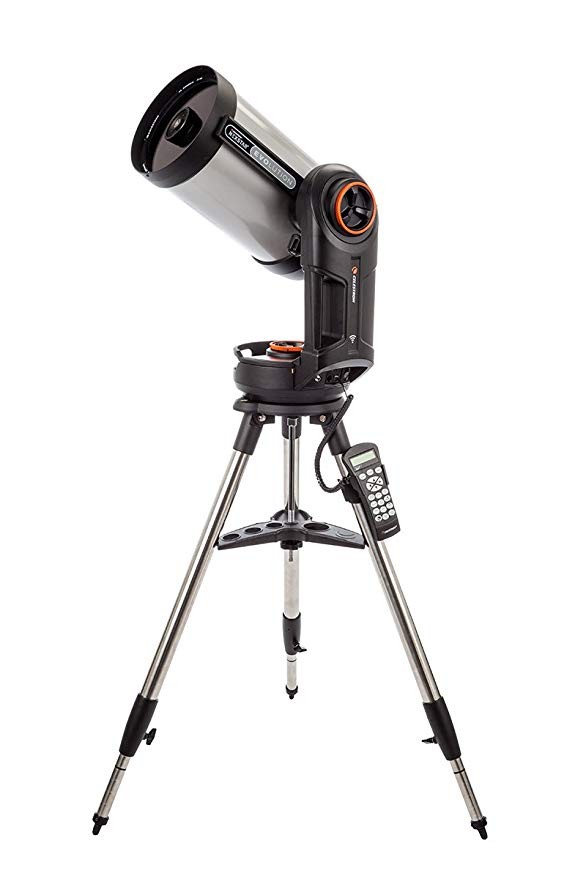
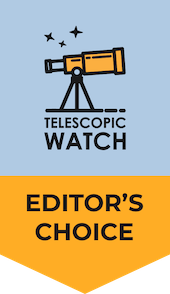

I own an Evolution-8 and I am quite satisfied with its visual use and very satisfied with the ease of alignment but very disappointed with some aspects of the electronics because often and in an absolutely unpredictable way, the push-button panel stops communicating with the instrument and forces me to redo the alignment. I then bought a second push-button panel, thinking that the problem was a defect of the same, but after a while I had the same problems. Also the wi-fi disconnects often with various smartphones and tablets. Grrr ….